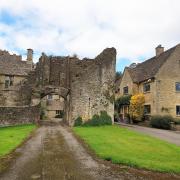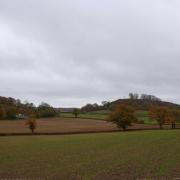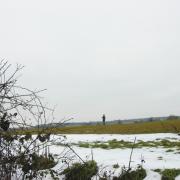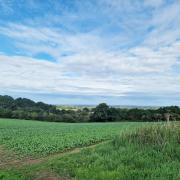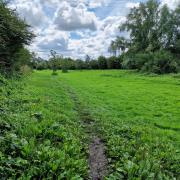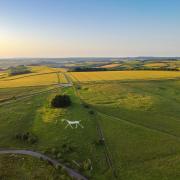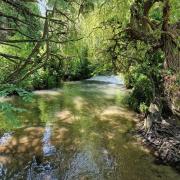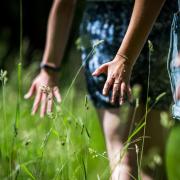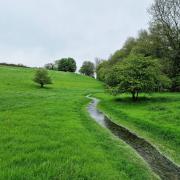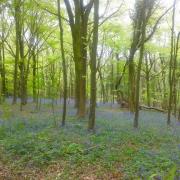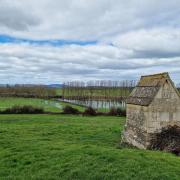Berkeley can lay claim to a long and vibrant history, but would you dare live there? Castle and town have more than their fair share of dark tales. Here, Kirsty Hartsiotis focuses on the area around the castle and church
Berkeley was there long before its castle. The town goes back to before the ninth century. In the years before the Norman Conquest, it belonged to one of the most powerful people in the land – Earl Godwin. Today, Godwin is nowhere near as famous as his son, Harold Godwinson, who lost his eye, his kingdom, and his life in 1066, but in his lifetime Godwin held great power in the land. It’s said that he rose from humble beginnings in the Forest of Dean – but that’s another story.

The Berkeley of Godwin’s time was dominated not by a castle but by a nunnery. The church of this nunnery was probably in much the same place as today’s parish church. St Mary’s Church is unusual in that it doesn’t have a tower – or at least it doesn’t have one that’s attached to the church. The tower stands on the other side of the churchyard. There’s no sinister reason for this. Another, older church was attached to the tower, but no longer stands today.
Our tale concerns that early church – a tale recorded in the 12th century by the historian William of Malmesbury, about a woman who lived in Berkeley, a woman who was neither young nor old – a woman, let’s say, of a certain age. Although she had been a respectable wife and mother, once her husband was in his grave and her children had fled the nest, this woman threw herself at life with open arms. Being rich, she ate fine foods and wore fine clothes and her fingers dripped with jewels.
That might not have been a problem, but she was addicted to other practices that perhaps don’t bear description between the covers of this magazine. Not only was she lost in her life of vice, but she had yet stranger habits. She had made a friend out of a jackdaw who visited her house most days. One day as she was preparing a feast for herself, the jackdaw flew into the kitchen and spoke to her. In horror she dropped her knife.
‘Some dreadful calamity is coming!’ she cried.

No sooner had she uttered these words than there was a knock at the door. A grim-faced messenger told her that her eldest son and all his family had died in an accident. The woman loved her children and grandchildren dearly. The shock was too much. She took to her bed and summoned her two surviving children – a monk, and a nun from Berkeley’s nunnery.
The two hurried to their mother. Her jewels and fine clothes were forgotten. To her children she suddenly looked old, as if death were standing at her shoulder.
She beckoned them closer. ‘My children, you find me waiting for death – but I cannot greet him as friend. I have lived my life without a care, given in to every vice, embraced every pleasure the flesh could afford me. My neighbours wondered at how such a wicked woman could have three such kind and pious children. I wondered at it myself. But now God punishes me. He’s taken your brother, his wife, and all their children. It will be my turn next – and it’s the Devil who’ll come for me. I’d hoped that your prayers might save me, but it’s too late for that now.’

The woman had a plan. If she couldn’t stop death, then she could stop the Devil claiming her. She told her children to sew her corpse into the skin of a stag and place it in a stone coffin. They were to fasten down the lid with lead and iron, wrap three thick iron chains around it, and weigh the whole thing down with a stone, and the whole lot wrapped around with three thick iron chains. As if that wasn’t enough, she asked for prayers to be chanted for her. If, after three nights, she was still safe, they could bury her body.
When the woman died, her children followed her instructions to the letter. The body with all of its protections was placed in the nunnery’s church. The church door was bolted shut, locking in the nuns and their priests for the three long days and nights. For two days they sang and prayed. When the sun set on the second day, the devils came. Round the church they flew, screeching so loud that the voices of those inside faltered. Then they burst into the church.
Straight to the coffined and chained corpse they went. They broke the first two chains as easily as a knife slices through butter – but the last chain held. The church shook with the demons’ shrieks and cries. The priests and nuns kept praying, their eyes tight shut.

At cockcrow on the third day the Devil himself came. The priests and nuns fell silent. Their hair stood on end as the horned figure approached the coffin and commanded the dead woman to rise.
‘I cannot,’ cried the corpse, ‘on account of the chain.’
‘And yet you will.’ The Devil reached down and broke the chain as if it were a flower stem. He kicked off the coffin lid, lifted out the woman, and carried her outside. A horse was waiting, its back studded all over with iron hooks to tie her down. The Devil slapped the horse on the rump and off it shot, out of sight, leaving nothing behind save the woman’s scream, which could be heard for four miles around – even further than the screams of King Edward II, killed at the castle many years later, whose screams only reached three miles.
Not long after all this the nunnery was closed, by none other than Earl Godwin, who wanted Berkeley’s rich lands. Had he got wind of this tale and the dubious happenings at the nunnery? Whether he had or not, he took no chances. It’s said he snuck his nephew into the nunnery, pretending to be sick and needing care, but with the mission to seduce each of the nuns in turn. It seems it worked… Godwin’s wife was so furious at her husband’s duplicity that she would eat no food from the Berkeley estate. Godwin was not swayed. He simply bought the manor of Woodchester, near Stroud, to provide her with food.
The Godwins didn’t keep the estate long. With the arrival of William the Conqueror in 1066, the English lords lost their land. By the time of the Domesday Book, completed in 1084, Berkeley was in the hands of the family who hold the castle to this day.

That’s not – quite – the end of the town’s dark tales. Everyone of course knows the fate of Edward II at the castle, but less well-known, is that in the time of Henry VII, in the 15th century, a monstrous toad was discovered at Berkeley. It’s said that some wicked lord had fed it two of his children to appease it; though the reason why it needed appeasing is lost in time. For an age the toad was lost, too, until it was discovered, grossly fat and more than a foot long! The toad was once displayed in Berkeley Castle, perhaps next to the silver cup some say belonged to Earl Godwin. The toad was in fact a stuffed seal! Yet you can spy a toad in Berkeley today. Have a careful look in St Mary’s and see if you can find it, squatting over the heads of two women.

ESSENTIALS
Parking: If you’re visiting the castle, you can park there. There’s limited free parking in the town.
Toilets and refreshments: Berkeley Castle has a tea room. Eateries in the town include the Berkeley Tea Rooms.
Transport links: You can reach Berkeley by bus from Bristol (62, HCT Group) and from Thornbury and Sharpness (207, Jackies Coaches).
Map: OS Explorer 167 Thornbury, Dursley and Yate.
Further reading: Tales of Witchcraft and Wonder, by Candia and Tony McKormack.
LINKS
Berkeley Castle: berkeley-castle.com/history
St Mary’s Church: stmarys-berkeley.co.uk/history
Kirsty Hartsiotis is a Stroud-based storyteller, writer and speaker. Her books include Wiltshire Folk Tales, Gloucestershire Ghost Tales and Gloucestershire Folk Tales for Children. She is also the curator of decorative and fine art at The Wilson Art Gallery and Museum, Cheltenham.
Follow Kirsty on Twitter: @StroudStory








